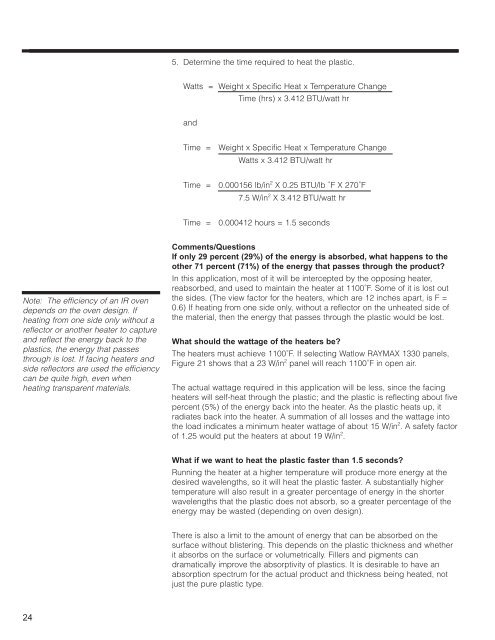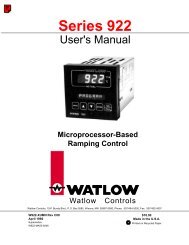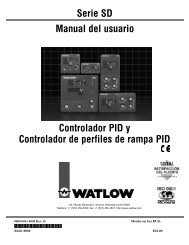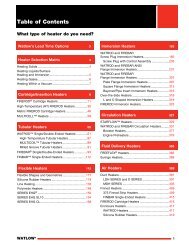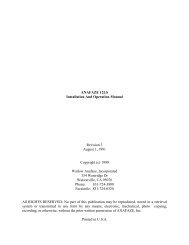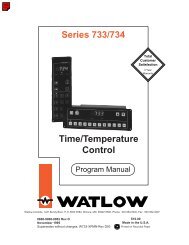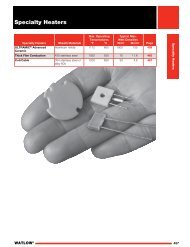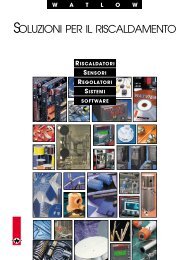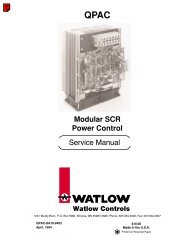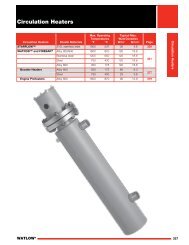RADIANT HEATING WITH INFRARED - Watlow
RADIANT HEATING WITH INFRARED - Watlow
RADIANT HEATING WITH INFRARED - Watlow
You also want an ePaper? Increase the reach of your titles
YUMPU automatically turns print PDFs into web optimized ePapers that Google loves.
Note: The efficiency of an IR oven<br />
depends on the oven design. If<br />
heating from one side only without a<br />
reflector or another heater to capture<br />
and reflect the energy back to the<br />
plastics, the energy that passes<br />
through is lost. If facing heaters and<br />
side reflectors are used the efficiency<br />
can be quite high, even when<br />
heating transparent materials.<br />
24<br />
5. Determine the time required to heat the plastic.<br />
Watts = Weight x Specific Heat x Temperature Change<br />
and<br />
Time (hrs) x 3.412 BTU/watt hr<br />
Time = Weight x Specific Heat x Temperature Change<br />
Watts x 3.412 BTU/watt hr<br />
Time = 0.000156 lb/in 2 X 0.25 BTU/lb ˚F X 270˚F<br />
7.5 W/in 2 X 3.412 BTU/watt hr<br />
Time = 0.000412 hours = 1.5 seconds<br />
Comments/Questions<br />
If only 29 percent (29%) of the energy is absorbed, what happens to the<br />
other 71 percent (71%) of the energy that passes through the product?<br />
In this application, most of it will be intercepted by the opposing heater,<br />
reabsorbed, and used to maintain the heater at 1100˚F. Some of it is lost out<br />
the sides. (The view factor for the heaters, which are 12 inches apart, is F =<br />
0.6) If heating from one side only, without a reflector on the unheated side of<br />
the material, then the energy that passes through the plastic would be lost.<br />
What should the wattage of the heaters be?<br />
The heaters must achieve 1100˚F. If selecting <strong>Watlow</strong> RAYMAX 1330 panels,<br />
Figure 21 shows that a 23 W/in 2 panel will reach 1100˚F in open air.<br />
The actual wattage required in this application will be less, since the facing<br />
heaters will self-heat through the plastic; and the plastic is reflecting about five<br />
percent (5%) of the energy back into the heater. As the plastic heats up, it<br />
radiates back into the heater. A summation of all losses and the wattage into<br />
the load indicates a minimum heater wattage of about 15 W/in 2 . A safety factor<br />
of 1.25 would put the heaters at about 19 W/in 2 .<br />
What if we want to heat the plastic faster than 1.5 seconds?<br />
Running the heater at a higher temperature will produce more energy at the<br />
desired wavelengths, so it will heat the plastic faster. A substantially higher<br />
temperature will also result in a greater percentage of energy in the shorter<br />
wavelengths that the plastic does not absorb, so a greater percentage of the<br />
energy may be wasted (depending on oven design).<br />
There is also a limit to the amount of energy that can be absorbed on the<br />
surface without blistering. This depends on the plastic thickness and whether<br />
it absorbs on the surface or volumetrically. Fillers and pigments can<br />
dramatically improve the absorptivity of plastics. It is desirable to have an<br />
absorption spectrum for the actual product and thickness being heated, not<br />
just the pure plastic type.


